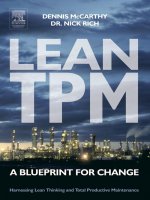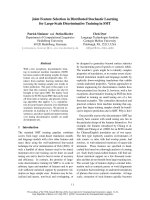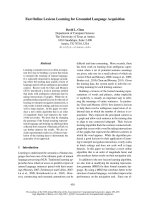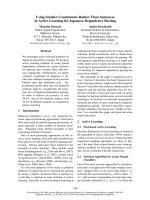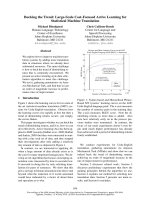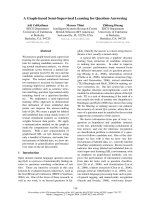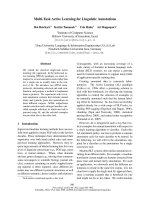Learning for change
Bạn đang xem bản rút gọn của tài liệu. Xem và tải ngay bản đầy đủ của tài liệu tại đây (913.04 KB, 64 trang )
1
Learning for Change:
Principles and practices
of learning organisations
Bruce Britton
swedish
mission council
5/2002
2002
2
swedish mission council
se - 172 99 sundbyberg
www.missioncouncil.se
print: Alfa-Print, sundbyberg
form: viktoria isaksson/SMR
illustrations: monica eriksson/illume
isbn: 91-85424-78-1
© copyright 2002 swedish mission council
3
Contents
Introduction 4
Learning in Development Organisations 5
What is learning? – Individual learning – Collective learning
What is a Learning Organisation? 10
Definitions – Characteristics of a Learning Organisation
– A Learning Approach to Development
Understanding the Learning Organisation: The Eight Function Model 14
Creating (and Sustaining) a Learning Culture (1) – Gathering Internal Experience (2)
– Accessing External Learning (3) – Communication Systems (4) – Mechanisms for
Drawing Conclusions (5) – Developing an Organisational Memory (6) – Integrating
Learning into Strategy and Policy (7) – Applying the Learning (8)
Learning and the Planning Cycle 30
Planning – Action – Reflection – Learning
Barriers to Learning in Organisations 34
External Barriers – Internal Barriers – Tools and strategies for Overcoming Barriers
to Learning – The Role of the Senior Manager
Tools for Learning in Organisations 41
Action Learning Sets – Advice Network Mapping – Case Study Development
– Exchange Programmes – Exit Interviews – Learning NGO Questionnaire
– The ‘Learning Before, During and After (LBDA) Model – Learning Maps
– Learning History – Yellow pages
Creating a Learning Organisation – A Checklist for Change 49
Further Reading 50
Glossary 57
Acknowledgements 63
4
Introduction
Member organisations have a strong commitment to expressing solidarity through internatio-
nal development.
During more recent years, the churches have received extensive government support for their
development aid work. Since 1980, SMC has had a framework agreement with Sida (Swedish
International Development Cooperation Agency). The task as co-ordinating agency for this
agreement entails assessment of the organisations and their capacity for development work,
assessment and decisions concerning individual projects as well as evaluation and follow-up of
completed projects.
SMC has taken a pioneering approach among its members and other NGOs in Sweden in
promoting the concept of organisation development (OD). As a result of its interest in this
field, SMC has sponsored a number of workshops for its members which have included sessions
on organisational learning. These workshops were the subject of a study: Strengthening Organi-
sations North and South (Goold and Britton, 2000).
Internally, SMC has examined its own approach to organisational learning through two
workshops held in 2000 and 2001 and facilitated by the author of this book.
This book was commissioned by SMC as a way of further developing an understanding of
organisational learning in church-related organisations involved in international development.
It builds on an earlier paper written by the author, Bruce Britton, in 1998 (Britton, 1998) and
includes examples of how practice and thinking in the field of organisational learning have
evolved since then.
By publishing this document, The Swedish Mission Council wants to encourage its member
organisations and their partners to continue to build a practice that is truly developmental.
Sundbyberg October 2002
General Secretary
Göran Sturve
5
Learning in Development
Organisations
The enormous resources invested in development work
generate an imperative for learning. Yet, major studies
commissioned by donors concerning the
effectiveness of humanitarian relief have called into
question the ability of agencies to learn from their
experience and avoid repetition of disastrous
interventions such as in Rwanda and the Balkans
1
.
With donors increasingly question the value added
by Northern Civil Society Organisations in the aid
chain, the stakes for demonstrating the use of
learning to improve organisational performance have
never been higher. However, it also seems that over
the past few years development organisations have taken
serious notice to this ‘wake up call’ from donors.
An indicator of the increasing recognition of the importance of
learning in development has been the World Bank’s reinvention of itself since 1996 as a
“knowledge bank” for development. Although this is partly a re-branding exercise, the World
Bank has made a considerable investment in both people and technology to build on its
credentials as a focal source of data and analysis on development issues. This has led the World
Bank to develop two high-profile initiatives: the Global Development Network and the
Development Gateway. Whilst the motives behind these initiatives are, quite understanda-
bly, the subject of considerable debate
2
, the fact that the World Bank has placed such emphasis
on knowledge as well as money as assets for development has been very influential in the
thinking of other development agencies, including Civil Society Organisations.
1 Minear, 1998
2 Wilks, 2001 and King and McGrath, 2000
“In the aid business, doing good
isn’t enough. Setting an example isn’t
good enough in itself either, if the
example doesn’t translate into more
widespread improvements. If aid agen-
cies feel their operational work is good
and offers lessons worth emulating, they
must ensure that others learn from and
build on those lessons… All agencies,
then, must be learning organisations –
not just organisations that learn well,
but agencies that successfully dis-
seminate those lessons and pro-
mote uptake of good practice.”
(Thin, 1997)
6
Before embarking on an examination of the nature of learning organisations we need to have
a basic understanding of what we mean by learning and particularly what learning means in
the context of organisations.
What is learning?
Despite its apparent simplicity there is a remarkable range of contrasting
views about what learning is. Most of the debate is of mainly academic
interest but for practical purposes a useful distinction can be
made between ‘learning that’ and ‘learning how’. Learning
that involves acquiring information. Here, learning is seen
as a product: learning has taken place when information
is acquired, whether the information is used or not.
Learning how involves developing an ability to do
something. Here, learning is seen as a process leading
to an outcome: learning only takes place when the
ability is used in practice. Within the process approach,
judgements about whether an individual has learned
are based on whether there are observable
improvements in the individual’s performance.
The process approach to learning is the one that has
found the greatest resonance in development work
because both are based on the idea of change. According
to the process approach, assessments about whether a
development organisation is learning must be based on
whether there are observable improvements in its own
development practice or its ability to influence others.
Before moving on to examine the learning organisation concept in more detail, it
will be useful to pause and consider the ideas of individual and collective learning.
“In Chinese, the word
“learning” is represented by
two characters. The first character
means to study and is composed of
two parts: a symbol that means to
accumulate knowledge, above a symbol
for a child in a doorway. The second
character means to practice constantly,
and it shows a bird developing the
ability to leave the nest. The
upper part represents flying;
the lower symbol, youth.”
Senge et al (1994)
7
Individual learning
Contrary to what we may be told in our earlier years, learning is not about ‘knowing the
answers’. It is not just about studying and achieving qualifications. Learning is not measured by
examinations (which test only our understanding of theories) but is tested by judging its
usefulness through experience.
Individual learning is about personal growth and development; it is about increasing our self-
confidence and ability to solve problems; it is about increasing our effectiveness, improving
our performance and making the most of our experience.
In 1984 David Kolb developed a four stage model of how individuals learn from experience
which involves doing, reflecting, connecting and testing in a continuous cycle (see Figure 1). In
this model, learning starts by taking action, then
reflecting on the outcomes of the action, ma-
king connections with what we already know
and understand and then testing those
connections and new ideas through further ac-
tion. The doing and reflecting stages of the cycle
belong more to the concrete real world whereas
connecting and testing are more abstract. The
doing and testing stages are more action-
oriented whereas the reflecting and connecting
stages are more reflective in nature.
The learning cycle model underpins the concept
of individual ‘learning styles’: the idea that each
person has preferences for one or more stages
in the learning cycle. For example, when asked
to take on a new area of work, some people will
read as much theory as possible in order to make
connections with what they already know
(Theorists), whereas others will “jump in at the
m
o
r
e
c
o
n
c
r
e
t
e
m
o
r
e
a
b
str
a
c
t
m
o
re
a
c
t
i
o
n
m
o
r
e
r
e
f
l
e
c
t
i
o
n
D
o
i
n
g
R
e
f
l
e
c
t
i
n
g
C
o
n
n
e
c
t
i
n
g
T
e
s
t
i
n
g
3 For a comprehensive review of articles on experiential learning
see Tim Pickles (1996)
Figure 1: Kolb’s Learning Cycle
3
8
deep end” and try things out in practice first (Activists). By being aware of their preferences,
individuals can choose to strengthen their ability to use all stages in the learning cycle in order
to make themselves better ‘all round’ learners. A useful questionnaire exercise for identifying
individual learning styles is available
4
. It can be used to introduce the learning cycle and help
individuals develop practical strategies for understanding and strengthening their learning skills.
Individual learning is the starting point of the learning organisation. Learning organisations
need individuals who are skilled, enthusiastic learners; who are curious and unwilling to simply
accept things as they are; who are willing to take risks and challenge assumptions and who are
driven by the desire for doing things better.
Collective learning
It is an obvious but important point that organisations cannot, themselves, learn; it is the
individuals within them who learn. However, there is more to a learning organisation than
simply a collection of individuals who are learning. Learning must be happening on two levels:
the individual level and the collective level. Collective learning in an organisation is what we
call organisational learning. Indeed, organisational learning can be defined as ‘the changing of
organisational behaviour which occurs through a collective learning process’.
So “without individual learning there can be no question of organisational learning. On the
other hand, an organisation has not automatically learned when individuals within it have
learned something. Individual learning is a necessary but not a sufficient condition for
organisational learning”
5
.
The practical implications of this understanding of organisational learning are important but
require a brief examination of three important concepts: information, knowledge and wisdom
(see Box 1).
Learning can be understood as the process that transforms information into knowledge and
then into wisdom. Information only has value when it is converted into knowledge. Knowledge
becomes useful when it is combined with experience to create wisdom which can be used to
4 Honey and Mumford (1986)
5 Swieringa and Wierdsma (1992, p 33)
9
guide action. However, even wisdom has limitations if it is
locked in the minds of individuals and not shared with
others.
Wisdom which is personal and available only to the
individual and not shared is what Ikujiro Nonaka
6
calls
tacit wisdom. Tacit wisdom is highly personal and may be
difficult to communicate to others. Making personal
wisdom available to others is the central activity of the
learning organisation. This process is called articulation
and it is the basis of organisational learning.
A learning organisation, therefore, supports its members
to translate information into knowledge and wisdom and
then converts the tacit wisdom of its individual members
into explicit wisdom which can be accessed and used by
others both within and outside the organisation. The pro-
cess of articulation involves helping people express what
may initially appear to be inexpressible – their subjective
insights, intuitions and understanding developed through
experience. Individuals may need considerable support and
encouragement to make their wisdom available to others.
Organisational learning, therefore, requires what Donald
Schon
7
has called reflective practitioners working in a
supportive learning environment (a learning culture).
Reflective practitioners are individuals who are skilled in the process of reflecting on their
practice whilst they are acting, and doing so in a way that enables them to do their jobs more
thoughtfully and effectively. Learning organisations need reflective practitioners who are able
and willing to continuously challenge their own assumptions and the assumptions of their
colleagues in a constructive way which generates new insights and leads on to the development
of explicit wisdom.
Box 1: Information, Knowledge and
Wisdom
Information
This is the simple fragmented raw
material of facts, opinions and ideas
of which knowledge is made.
Knowledge
Systematically organised information
which, by the processes of analysis,
comparison, testing and generalising
can be used to answer complex
questions.
Wisdom
The combination of the facts and
insights of knowledge with practical
experience in a way that can usefully
guide action.
6 Nonaka (1991)
7 Schon (1987)
10
What is a Learning
Organisation?
The term ‘learning organisation’ first emerged in the late 1980s. Despite its origins in corporate
sector management thinking, it is an idea that immediately had a resonance in the world of
international development.
When I wrote this in 1998 I underestimated the enthusiasm with which not only NGOs but
many other Civil Society Organisations involved in development work would embrace the
concept of the learning organisation. Nowadays almost every type of organisation has taken
on not only the underpinning ideas but also the terminology of the learning organisation. For
example, churches and their development organisations are increasingly recognizing the
importance of learning to enable them to adapt and change and have the capacity to rapidly
acquire and use new knowledge when faced with emerging challenges. In short, as one church
has declared:
8 Source: Valenzuela, Denise (April 1999) Helping the church become a learning organisation, Visitor magazine, Columbia Union
Conference of the Seventh Day Adventist Church.
“Whilst there are still relatively few NGOs which would call themselves ‘learning organisa-
tions’, examples of good practice in NGOs are not hard to find. Indeed, as NGOs
become more aware of the concept and its application, we are likely to see more NGOs
consciously adopting the underpinning ideas of the learning organisation in their ap-
proaches to work.”
“To accomplish our mission we must learn. Both as individuals and as Church organisa-
tions, we must learn to be more effective each day than the day before. The significance
of our vision and values needs to be heard and felt by church members. A complete
understanding of facts, trends and skills – a mission transformed by what God has taught
us through His grace – is the end result of being a learning organisation.”
8
11
Definitions
The search for a single all-encompassing definition of the learning organisation whilst attractive
is frustrating and, in the end, may even be misguided. It can be argued that the most useful
definition of the learning organisation is the one that each organisation develops for itself.
However, it would be profoundly ironic if we did not examine and reflect on the fruits of the
experience of others in our search for an understanding of what it means to be a learning
organisation.
One of the earliest definitions is that of PETER SENGE who, in his ground-breaking book ‘The
Fifth Discipline’ describes learning organisations as “organisations where people continually expand
their capacity to create the results they truly desire, where new and expansive patterns of thinking
are nurtured, where collective aspiration is set free, and where people are continually learning to see
the whole together”.
9
MIKE PEDLER
10
emphasises the importance of learning for change in his definition of the learning
organisation as “an organisation that facilitates the learning of all its members and continuously
transforms itself”.
DAVID GARVIN’s definition of the ‘learning organisation’ as an organisation which is “skilled at
creating, acquiring, and transferring knowledge, and at modifying its behaviour to reflect new
knowledge and insights”
11
emphasises the importance of internal processes.
AIKEN AND BRITTON
12
, writing specifically about NGOs see the learning organisation as “An
organisation which actively incorporates the experience and knowledge of its members and partners
through the development of practices, policies, procedures and systems in ways which continuously
improve its ability to set and achieve goals, satisfy stakeholders, develop its practice, value and
develop its people and achieve its mission with its constituency”.
Finally, JAMES TAYLOR from the South African Community Development Resource Association,
CDRA, defines the learning organisation as “The organisation which builds and improves its own
practice consciously and continually devising and developing the means to draw learning from its
own (and others’) experience”.
13
9 Senge (1990)
10 Pedler et al (1991)
11 Garvin, 1993
12 Aiken and Britton (1997)
13 Taylor (2002)
12
Each definition has something valuable to contribute to our understanding but clearly there is
no single all-embracing definition of precisely what is meant by the learning organisation. So,
how should we better understand the concept of the learning organisation?
Characteristics of a Learning Organisation
A more practical way to understand the learning organisation is to consider what its key char-
acteristics might be – in other words, what is it that makes learning organisations different?
One way of summarising the learning organisation is to say that it:
Recognises the need for change
Provides continuous learning opportunities to its members
Explicitly uses learning to reach its goals
Links individual performance with organisational performance
Encourages inquiry and dialogue, making it safe for people to share openly and take r
isks
Embraces creative tension as a source of energy and renewal
Is continuously aware of and interacts with its environment.
An important feature of learning organisations is that they are organised so that learning
happens at five levels
14
:
individual learning
team or work group learning (sharing lessons between individuals working together in
permanent work groups or temporary teams)
cross functional learning (sharing lessons between departments or sections eg between
fundraising and operational staff)
operational organisational learning (focusing on improving practice, increasing effective-
ness and efficiency)
strategic organisational learning (learning to deal with significant changes in the envi-
ronment which affect the overall strategy of the organisation)
In practice, there will be and should be considerable overlap between these levels.
14 Pearn, et al (1995)
13
A Learning Approach to Development
The idea that development is itself a learning process was originated by David Korten and Rudi
Klauss as long ago as 1984. In their influential book People Centered Development they maintained
that learning is a necessary and integral part of any development organisation’s approach to
sustainable development. Indeed, they went as far as to propose a ‘learning approach to
development’ comprising three phases:
Learning to be effective The organisation must first learn about the most effective
ways of working in order to achieve its goals with the communities in which it works.
This involves setting up projects as ‘learning laboratories’ in which staff of the develop-
ment agency work with members of the community to develop an understanding of
their needs and devise an appropriate programme of assistance. Experimentation, risk-
taking, creativity and an ability to build on experience are crucial at this stage. Some
tolerance about the inefficient use of resources and the making of ‘mistakes’ is also
required.
Learning to be efficient The organisation must then learn to use its resources effi-
ciently so that it can achieve its goals at an acceptable cost. Ideally this will require the
organisation to reduce its costs to the point where local communities can sustain the
benefits of the work indefinitely.
Learning to expand Finally, organisations must learn to expand or ‘scale up’ their work
so that the maximum number of people can benefit from the programmes which have
been piloted. This involves generalising from particular experiences in order to apply
successful approaches to development in new settings offering different challenges.
Each of these phases emphasises learning as an integral component of the development pro-
cess. Increasingly, development organisations are addressing the three areas of learning at the
same time rather than in sequence.
14
Understanding the Learning Organisation:
The Eight Function Model
15 Britton (1998)
Earlier, we examined definitions of the learning organisation and noted that some emphasise
the importance of internal processes that enable collective learning. In this section we will
explore this further by posing the question: ‘What does an organisation need to do in order to
learn?’
The Eight Function Model
15
for organisational learning attempts to answer this question by
identifying the eight key functions that any organisation must master in order to learn effectively.
These are:
1. Creating a Learning Culture
2. Gathering Internal Experience
3. Accessing External Learning
4. Communication Systems
5. Mechanisms for Drawing Conclusions
6. Developing an Organisational Memory
7. Integrating Learning into Strategy and Policy
8. Applying the Learning
The eight key functions are summarised in Figure 2 and are examined in turn.
15
Creating (and Sustaining) a Learning Culture (1)
If organisational learning is to be a collective, organisation-
wide activity it must become part of the organisation’s culture.
Organisation culture means the shared assumptions that an
organisation’s members learn and pass on to new members.
Edgar Schein proposes a three-level model for understanding
organisational culture (see Figure 3).
The most obvious level of organisational culture are its
artifacts – the observable structures, systems, processes and
documentation of the organisation and the behaviour of its
members.
Underpinning the artifacts are the espoused values – the
strategies and goals of the organisation and what its members
say to explain how the organisation works and their own
behaviour within it.
Figure 2: Eight Key Functions of a
Learning Organisation
Figure 3: The Three Levels of
Organisational Culture
A
c
c
e
s
s
i
n
g
E
x
t
e
rna
l
L
e
a
r
n
in
g
Applying the Learning
C
o
m
m
u
n
i
c
a
t
i
o
n
Sy
ste
m
s
C
r
e
a
tin
g
a
L
earn
in
g
C
u
l
t
u
r
e
G
a
t
h
e
r
i
n
g
I
n
t
e
r
n
a
l
E
xp
eri
e
n
c
e
D
r
a
w
in
g
C
o
n
c
l
u
sio
n
s
De
velo
p
in
g
an
O
r
g
a
n
i
s
a
t
i
ona
l
M
em
o
r
y
I
n
t
e
r
g
r
a
t
i
n
g
L
e
a
r
n
i
n
g
i
n
t
o
Strat
egy an
d
P
o
l
i
c
y
1.
2.
3.
4.
5.
6.
7.
8.
See fig. 3
Underlying
Assumptions
Visible
organisational structures
and processes
Strategies, goals,
philosophies (espoused
justification)
Unconscious
taken-for granted beliefs,
perceptions, thoughts and
feelings
Espoused
Values
Artifacts
Source: Britton (1998)
16
At the most fundamental layer of organisational culture are the underlying assumptions,
often unconscious, that shape the organisation’s beliefs.
A learning culture is an organisational environment which enables, encourages, values, rewards
and uses the learning of its members both individually and collectively. It is a culture which has
integrated a learning approach to its work at all of the three levels of culture described above.
Organisations with a learning culture demonstrate that
learning is a legitimate activity. In other words, learning is seen as an integral part of
each individual’s work responsibilities, not something to be done in the individual’s own
time;
learning is encouraged and supported. Managers make it part of their responsibility to
ensure that their colleagues are given personal encouragement to contribute to the de-
velopment of the organisation’s practice and policy;
learning is given adequate resources. There is a recognition that learning takes time and
it may also require other resources, including funding;
learning is rewarded. Individuals who contribute to the organisation’s evolution are
given recognition for their efforts and are provided with opportunities to represent the
organisation’s thinking to others;
the organisation aims to overcome its internal barriers to learning. Strategies for ad-
dressing internal barriers to learning, based on a systematic analysis, are devised and
made clear to all members of the organisation.
Indicators of a learning culture can be seen when colleagues ask questions of one another;
when colleagues constructively challenge each other’s assumptions; when colleagues openly
discuss problems and mistakes and convert these into learning; when mistakes are rarely repeated
more than once; and when problems are exposed and dealt with without blame.
Indicators of an organisational culture that is not supportive of learning would include: colleagues
giving way to the views of others simply because of their status; colleagues being over-cautious
about trying out new ideas; when the organisation is continually repeating the same mistakes;
blaming others is common-place; and individuals ‘burying’ problems so that they do not
come to the attention of others.
17
Tools and strategies for Creating and Sustaining a Learning Culture
What practical lessons can we learn from the experience of other organisations about how
organisations can develop a learning culture? Some ideas that have worked well are:
Ensure that there is top level management support for organisational learning
Help individuals to learn how to learn
Recognise that all organisations learn but not all organisations learn consciously and
effectively – this is the key to organisational learning
Demonstrate positive learning behaviours through example
Devise an organisational policy on learning
Encourage thinking ‘outside the box’ leading to double-loop learning
Reward individuals for the contribution they make to the organisation’s learning and
performance improvements (often, simple recognition is enough)
Make available resources and infrastructure for individual and collective learning
Build learning reviews into existing organisational procedures such as individual supervi-
sion and appraisal sessions and team meetings.
Gathering Internal Experience (2)
Organisations have two major sources of knowledge: the organisation’s own internal experience
and the lessons learned from other organisations, including community based organisations,
multi-lateral agencies, academic and research institutions and other Civil Society Organisa-
tions.
The process of gathering internal experience and changing it into practical and accessible
lessons learned is at the centre of the learning organisation. An understanding of implicit and
tacit knowledge and how the two inter-relate is essential to carrying out this function.
18
The British NGO Tearfund has introduced a system of Learning Reviews to identify lessons
learned after pieces of work have ended.
Action Aid uses two systems to capture learning within their organisation. An Annual Review
Reflection Process (ARRP) is used at field, country, regional and international levels to identify
lessons learned. The development of case study material is a key ingredient.
Many organisations are taking advantage of the power of information and communications
technology (ICT) to enable a more effective sharing of learning between their members. For
example, organisational intranets are now commonplace. However, intranets are only a tool
and must be designed so that they are accessible, navigable and have genuinely useful content.
Documents are a more common source of information. Indeed many organisations are awash
with reports, memos, minutes, project materials and other notes to the extent that staff don’t
have time to read them all let alone identify what is useful from what isn’t. As a result, a great
number of valuable lessons are undoubtedly lost. The value of these internal, unpublished
documents (sometimes called ‘grey literature’) can be greatly enhanced if it is made clear on
each: its purpose and content (key words can help subsequent document retrieval), who should
read it, who wrote it, what are the actionable recommendations, who has responsibility for
implementation and how and when progress will be measured.
Tools and strategies for Gathering Internal Experience
Organisations have found the following practical ideas useful for gathering their internal
experience:
Ensure that all monitoring, reviews and evaluations have an explicit learning function
(as well as an accountability function)
Regularly review the wider use made of monitoring, review and evaluation data
Build systems for making explicit the tacit knowledge of individuals
Build in enough spare capacity to allow time for individual and collective reflection
Use the Learning Before, During and After Model
16
19
Ensure that documents include specific actionable recommendations
Use ICT to enable greater accessibility of ‘grey literature’
Develop an internal database of staff/partner expertise. Use Advice Network Mapping
to identify informal sources of expertise valued by staff
Ensure that work proposals include a section on who and what have been consulted
during their preparation
Establish internal Action Learning Sets.
Accessing External Learning (3)
Learning in development orga-
nisations has two major sources:
the organisation itself and
lessons learned by others. It is
not enough to be clear about
what the organisation itself has
learned from its own experience,
it must actively seek out learning
from elsewhere. This requires a
genuine open-ness and willing-
ness to enter into dialogue with
a wide range of organisations in
the corporate and public sectors
as well as Civil Society (which,
in turn, means being willing to
share the learning from failure
as well as success).
Partnership work with other or-
ganisations is becoming more
Box 2: WWF Exchange Programme
The WWF Exchange Programme is a vehicle for sharing
technical and managerial expertise between environmental and
conservation organisations. It forms part of the ‘Across the
Waters’ capacity-building initiative coordinated by Marc
Sanjuan of the WWF Mediterranean Programme Office.
By developing agreed learning objectives and a programme of
focused activities, individuals from different organisations are
linked together for short-term visits of 5-14 days or longer term
‘stages’ which may last from three weeks to three months.
Exchanges are rigorously debriefed and evaluated by the ‘guest’
and the ‘host’. Learning gained from the Exchange programme
is made available through the ‘Information Hub’ element of the
Across the Waters capacity-building programme.
Further details of the programme can be found at
www.atw-wwf.org
20
common and this approach opens up the boundaries of organisations to learn from one an-
other. Common ways of accessing learning from other organisations are: attending (or organi-
sing) training courses, attending (or organising) workshops and conferences; organising
secondments or exchanges; developing and joining networks (virtual or tangible); and
developing or joining communities of practice (either tangible or on-line)
Tools and strategies for Accessing External Learning
In order to enable learning from outside the organisation, the following ideas may be useful:
Value the learning potential of all contacts with the ‘outside world’
Ensure that mutual learning with ‘partners’ is built into partnership agreements
Develop organisational Yellow Pages - an accessible organisational database of individual
and organisational contacts
Link in to a range of networks, and communities of practice (real-world and virtual)
Seek out opportunities for joint working with organisations that have specific areas of
expertise, including academic institutions
Organise regular staff visits, exchanges and secondments. Ensure that these are well-
planned, focused, recorded and debriefed.
Communication Systems (4)
If knowledge is the lifeblood of the organisation then it requires a circulatory system to enable
it to constantly reach and stimulate its component parts. Communication systems – both
formal and informal are the circulatory system for knowledge and provide life-support for
learning.
21
With today’s availability of information and communication technology, there is an increasing
assumption that organisational learning simply requires the communication of information.
The danger is that the illusion of ‘more is better’ encourages greater and greater emphasis on
moving information and less on identifying and exchanging knowledge. Internal email networks
that encourage the thoughtless sharing of information are more likely to add to the organisation’s
problems by overloading recipients than helping those individuals to find solutions.
What is needed is a focus on quality and relevance of what is communicated rather than
simply increasing its quantity and availability.
Tools and strategies for Communication
In these days of Information and Communication Technology, it has never been easier to
share information, but we should not fool ourselves into thinking that this is the same as
sharing knowledge. The following ideas recognise the importance of ‘people-based’ as well as
‘technology-based’ tools and strategies.
Review and develop the learning potential offered by existing communication systems.
Encourage and support the development of channels for South-North, South-South as
well as North-South and North-North communication
Develop ‘listening’ as well as ‘telling’ communication skills
Use Learning Maps to illustrate the flow of information and knowledge and to identify
bottle-necks and potential areas for strengthening communications
Develop a knowledge management strategy
16
and recognise the difference between knowl-
edge and information
Encourage a discriminating approach to the use of email. For example, request all email
authors to clearly state what is required of each message recipient.
16 For help on this see Powell (1999)
22
Mechanisms for Drawing Conclusions (5)
The process of drawing conclusions and identifying lessons learned is the main characteristic
which differentiates organisational learning from simple information exchange. Drawing
conclusions converts information to knowledge, through a process of knowledge creation.
Identifying lessons learned
requires clarity about their nature
and scope. For example, are the
lessons learned location/culture-
specific; are they sector-specific;
do they relate to ‘our’ organisa-
tion only or do they have wider
application?
Drawing conclusions is a process
which needs to be seen as the
responsibility of the whole orga-
nisation and should, ideally,
happen as near to the source of
the experience as possible.
However, individuals may need
support in the process of reflec-
ting on and drawing conclusions
from their experience. Access to
organisational learning specialists
can greatly enhance the value
added through organisational
learning and may help to explain
why, particularly in large organi-
sations, specialist posts and teams
are increasingly common. One
such example is Christian Aid’s
CLEAR Team (see Box 3).
Box 3: Christian Aid’s CLEAR Team
Christian Aid is a large UK-based development NGO. In
2000 it established its CLEAR Team. CLEAR stands for
Coordinated LEarning And Review. The team promotes
and facilitates improved learning; develops a commitment
to and understanding of partnership approaches to work;
facilitates ownership of capacity building across the
organisation’s international work and enables others to
identify and embrace good practice in all their work.
The CLEAR team comprises eleven members, organized in
three main Units: the Capacity Building (CB) Unit, the
Communications Management (CM) Unit and the Planning
Monitoring and Evaluation (PME) Unit. The PME and CB
Units hold a wide range of resources for internal use by
Christian Aid staff.
The CLEAR Team also administers a Learning Initiatives
Fund (LIF) which is used to facilitate and promote ex-
change and reflective practice across Christian Aid’s
International Department. To date it has been used to
facilitate South-South exchanges, collective learning
events, documentation and sharing of case studies,
exploratory research and training events.
Source: Aidan Timlin, personal communication
23
Tools and strategies for Drawing Conclusions
Build intended learning into project/programme plans. Use an action-learning approach
to projects/programmes to generate and test hypotheses
Build ‘lessons learned’ as a heading into all monitoring systems, reviews and evalua-
tions
17
Strengthen links between existing processes of monitoring, review and evaluation and
organisational lesson learning
18
Prioritise particular areas of activity for more in-depth lesson-learning using thematic
reviews and research studies (field or desk)
Use Learning Reviews to identify lessons learned
Introduce action learning approaches which encourage action learning set members to
work towards practical solutions to identified problems
Ensure that staff supervision systems include a requirement to identify learning contri-
butions and learning needs.
Developing an Organisational Memory (6)
Remembering is a crucial element of organisational learning. Although some would say that
organisations, as such, cannot learn, no-one would deny that organisations can forget. If learning
is locked inside the heads of individuals, the organisation becomes very vulnerable if those
individuals leave the organisation. The old African proverb that “when an old person dies, a
library is lost” should no longer apply within organisations in these days of information &
communication technology. A learning organisation needs mechanisms which enable an
individual’s memory to be ‘down-loaded’ into a knowledge management system so that
everyone can continue to access that person’s knowledge long after the individual may have
moved on from the organisation.
17 For a particularly useful exploration of lesson-learning see Thin (1997)
18 Save the Children Norway has developed a useful questionnaire tool to examine their use and utilisation of evaluations (Jon
Kristian, Save the Children Norway, personal communication, 2002)
24
Many organisations have recognised the importance of unlocking each individual’s memory
but few have, as yet, developed systematic ways of ensuring that this knowledge and under-
standing are made widely accessible to colleagues both in their own organisation and beyond.
Some organisations now require all departing staff to go through an exit interview which
parallels the induction required at the beginning of an employment contract. A few organisa-
tions link departing staff with trainers to develop training materials based on their experience
(sometimes using case studies) which can be used either in-house or with other organisa-
Box 4: The Worldwide Fund for Nature K-Zone
The WWF K-Zone is an interactive knowledge zone which was established by the organisation’s ‘Ca-
pacity Building Unit’ (now called the Organisation Development Unit). Set up as an intranet, the K-Zone
is accessible to members of the WWF network and their partner organisations worldwide. The K-Zone
acts as a customized store of information, know-how and experience on diverse issues ranging from
organisational development and communication to detailed practice issues. The K-Zone is based on
three principles:
new data – it hosts the most up-to-date information fresh from the fields of operation
relevance – the information comes direct from those living and working in the field and so offers tried
and tested solutions to practical, cultural and real problems.
interactivity/collaboration – to ensure it is a valuable, vibrant and versatile practical resource.
The site includes reports, tools, case-studies, specially commissioned theme papers and research studies.
Currently in a three-year pilot, the K-Zone is already proving its worth. As Debbie Heaney, the Knowl-
edge Management Programme Officer of the K-Zone says:
“Harnessing ICT enables information to be posted onto the K-Zone from anywhere in the world. The K-
Zone encourages staff to take a pro-active approach by sharing their experiences and lessons learned
with their colleagues - wherever those colleagues are in the world. By learning from each other’s experi-
ences can help reduce the risk of re-inventing the wheel and repeating mistakes. One of the K-Zone’s
greatest strengths lies in it’s partnership approach to information sharing to support WWF offices in their
ability to deliver environmental solutions and bring about social change. The technology enables staff to
post up and manage the information that they have identified to share themselves, and, or course, it can
be easily kept up to date.”
25
tions. At the very least, departing staff should be encouraged to ‘tell their story’
19
of their time
in the organisation in whatever way feels comfortable to them. This story can then be screened
for specific lessons that may be of more general interest.
The development of information communication technology has rapidly expanded the
possibilities for gathering, analysing, storing and sharing information. The use of email, on-line
discussion groups, databases, web-sites, downloadable documents, organisational intra-nets
and the creation of virtual learning communities and on-line learning provide an exciting, if
sometimes bewildering, range of opportunities for organisational and individual learning. It
has also spawned the field of Knowledge Management which is particularly relevant to
establishing and maintaining organisational memory.
An excellent example of how ICT has been used in a deliberate and well-planned way to
improve organisational learning is the World Wide Fund for Nature (WWF) ‘K-Zone’ (see Box
4)
Tools and strategies for Developing an Organisational Memory
Ensure that developing and maintaining organisational memory is a key element of a
knowledge management strategy
Ensure that the organisation minimises its vulnerability to the loss of knowledge through
the loss of individuals (using mechanisms such as exit interviews)
Using ICT, develop a system for storing and accessing grey literature that may otherwise
be lost to the organisation
Develop a systematic and accessible database of the organisation’s staff expertise, projects,
programmes and partners to encourage ‘know-whom’ as well as ‘know-how’
Make the organisation’s memory more widely available to others through the use of
downloadable documents, content-based web-sites and the publication of resource ma-
terials
19 The benefits of using narrative (story-telling) as a tool for knowledge management are becoming more widely recognised.
Further information on the use of narrative can be found at www.creatingthe21stcentury.org
23
